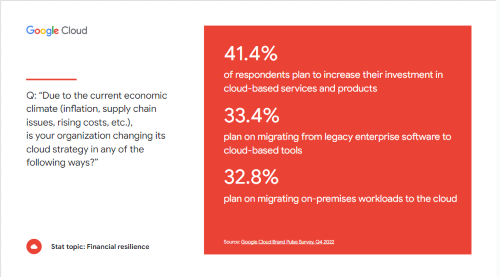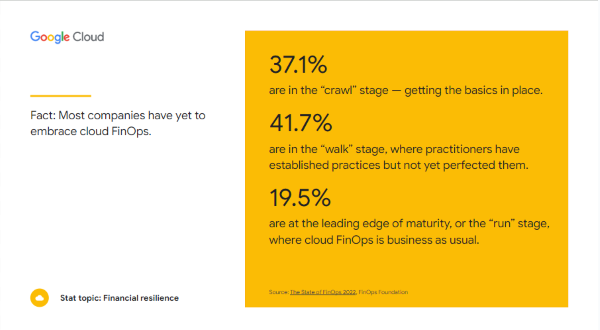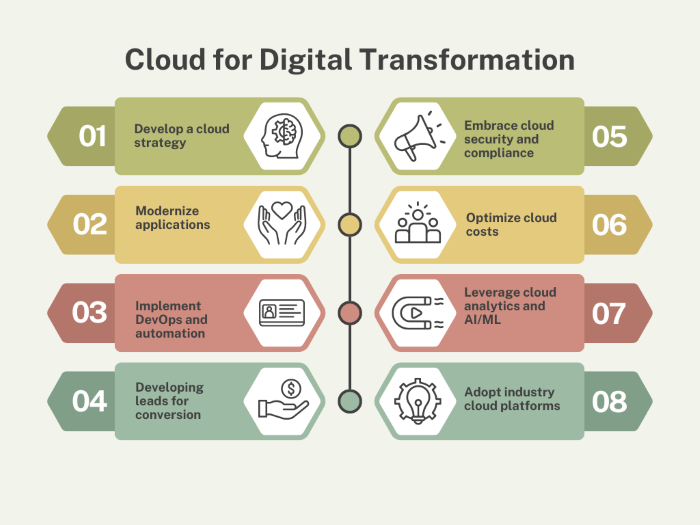Leveraging Cloud Computing for Seamless Digital Transformation

Cloud adoption is on the rise as organizations seek agility and cost optimization in uncertain economic times. According to a Google Cloud Brand Pulse Survey (Q4 2022), 41.4% of cloud leaders are increasing their use of cloud-based services and products, while 33.4% are planning to migrate from legacy enterprise software to cloud-based tools.

To equip C-level executives, IT leaders, and business decision-makers with the knowledge to navigate the rapidly evolving cloud computing landscape, this article aims to provide cutting-edge insights across critical areas that are shaping modern organizations.
These areas include strategies for enhancing business resilience, leveraging data analytics and AI/ML capabilities, optimizing cloud infrastructure, fortifying cybersecurity measures, and driving corporate sustainability initiatives. By addressing these pivotal topics, the article seeks to empower organizational leaders with the latest industry trends and best practices, enabling them to stay ahead of the curve and drive seamless digital transformation within their enterprises.
Challenge of leveraging cloud for digital transformation
Organizations across industries are grappling with the need to accelerate their digital transformation initiatives while maintaining operational efficiency and cost-effectiveness. Legacy systems and monolithic architectures hinder agility, innovation, and scalability, making it challenging to adapt to changing market dynamics and customer demands.
A 2022 FinOps Foundation survey revealed that most organizations are still in the early stages of cloud financial management (FinOps) maturity. Only 19.5% of the 572 respondents were at the "run" stage, where FinOps is fully integrated into business operations. The majority were either getting the basics in place (37.1% in the "crawl" stage) or had established practices but not perfected them (41.7% in the "walk" stage), highlighting the need for organizations to prioritize FinOps adoption to optimize cloud costs effectively.

The stakes are high, as a McKinsey study (2021) estimates that over $1 trillion in run-rate EBITDA across Fortune 500 companies is up for grabs by 2030 through effective cloud adoption and cost optimization. Gartner® ebook, Gartner's 2023 Top Strategic Technology Trends, 2022 predicts that by 2027, more than 50% of enterprises will use industry cloud platforms to accelerate their business initiatives, enabling a shift from generic solutions to industry-specific platforms.
Leveraging cloud computing can unlock significant benefits, including:
- Increased agility and innovation through on-demand scalability and access to cutting-edge technologies.
- Improved operational efficiency and cost optimization through automated policies, right-sizing, and FinOps practices (currently, only 19.5% of organizations have mature FinOps practices, according to the FinOps Foundation's 2022 survey).
- Enhanced business resilience and continuity by mitigating the risks associated with outdated legacy systems.
- Faster time-to-market and competitive advantages through industry-specific cloud platforms tailored to unique business requirements.
Embracing cloud computing is no longer an option but a necessity for organizations to remain competitive, agile, and future-ready in an ever-evolving digital landscape.
Leverage Cloud to Drive Seamless Digital Transformation
Organizations can leverage cloud computing to drive seamless digital transformation by following a structured approach and adopting industry best practices. According to Amazon Web Services (AWS), a leading cloud service provider, the key steps and industry practices include:

- Develop a cloud strategy: Establish a clear vision and roadmap for cloud adoption, aligning it with business objectives and digital transformation goals.
- Modernize applications: Migrate legacy applications to the cloud, leveraging cloud-native architectures, containerization, and serverless computing for enhanced scalability, agility, and cost optimization.
- Implement DevOps and automation: Adopt DevOps methodologies and leverage automation tools to streamline software development, testing, and deployment processes, enabling faster time-to-market and continuous innovation.
- Embrace cloud security and compliance: Implement robust cloud security measures, including identity and access management, data encryption, and compliance with industry regulations and standards.
- Optimize cloud costs: Implement FinOps practices, such as rightsizing resources, leveraging reserved instances, and automating cost optimization policies to maximize efficiency and minimize waste.
- Foster a cloud-centric culture: Encourage a culture of continuous learning, collaboration, and innovation, empowering teams to embrace cloud-native mindsets and methodologies.
- Leverage cloud analytics and AI/ML: Harness the power of cloud-based analytics, artificial intelligence (AI), and machine learning (ML) services to drive data-driven decision-making and unlock new business insights.
- Adopt industry cloud platforms: Explore industry-specific cloud platforms tailored to unique business requirements, accelerating digital transformation and time-to-value.
By following these steps and industry practices, organizations can effectively leverage cloud computing to achieve seamless digital transformation, fostering agility, innovation, and sustainable growth in the digital era.
Key Takeaways
Embracing cloud computing is crucial for organizations to achieve seamless digital transformation. By adopting industry best practices, such as developing a cloud strategy, modernizing applications, implementing DevOps and automation, and leveraging cloud analytics and AI/ML, enterprises can unlock agility, innovation, and cost optimization.
Explore our comprehensive Digital Transformation playbook blog series, which provides in-depth insights and practical strategies from industry leaders.




